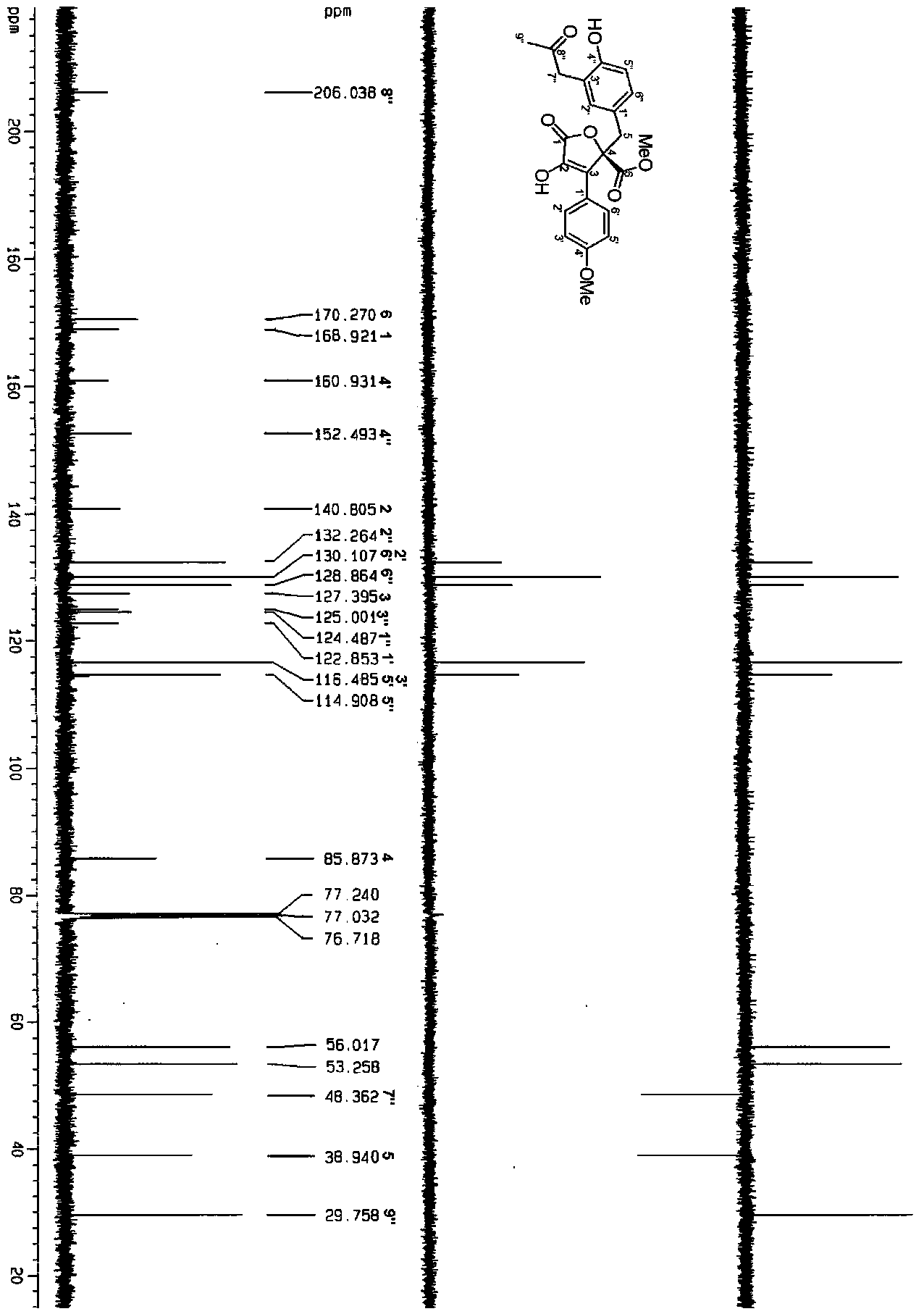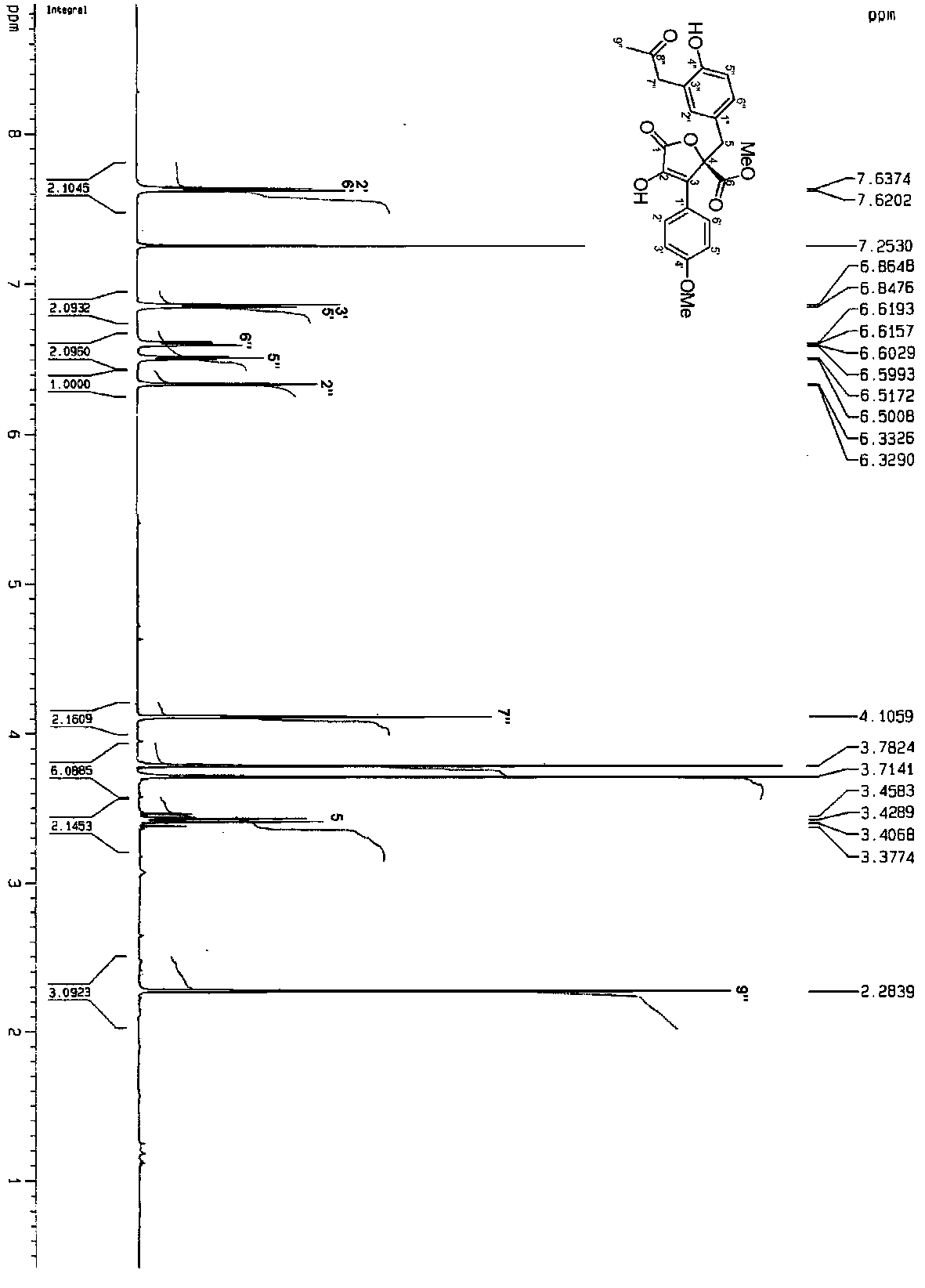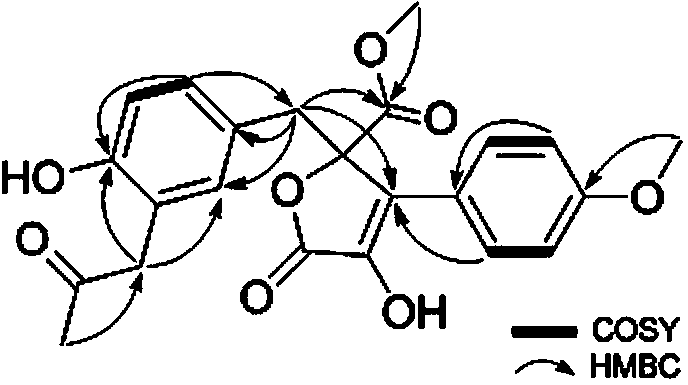Butyrolactone lignan compound and preparation method and application thereof
A technology of lignans and compounds, applied in the field of butyrolactone lignans and their preparation and application
- Summary
- Abstract
- Description
- Claims
- Application Information
AI Technical Summary
Problems solved by technology
Method used
Image
Examples
Embodiment 1
[0068] The Penicillium clade Penicillium group ( P. ramigena, YNCA0361) bacterial strain was inoculated on the potato dextrose agar medium at room temperature, cultivated for 7 days at 28 degrees Celsius, inoculated in 250 milliliters of conical flasks, each conical flask contained 100 milliliters of potato dextrose medium, and placed in 28 degrees Celsius for shaking culture for 5 day (180 rpm). The large-scale fermentation takes place in 200 500ml vonbach bottles, each containing 100g of rice and 120ml of distilled water. Each bottle was inoculated with 5.0 milliliters of bacteria-containing nutrient medium, and cultured at 25 degrees Celsius for 45 days. Extract by cold soaking with acetone with a volume concentration of 70% for 4 times, each time for 60 minutes, and combine the extracts; filter the extracts, concentrate the extracts under reduced pressure to 1 / 4 ~ 1 / 2 volume, let stand, filter out the precipitate, and concentrate Obtain 215g of extract a; extract a uses ...
Embodiment 2
[0070] The Penicillium clade Penicillium group ( P. ramigena, YNCA0361) strains were inoculated on potato dextrose agar medium at room temperature, and cultured at 28 degrees Celsius for 7 days. Inoculate in a 100 ml Erlenmeyer flask, each Erlenmeyer flask contains 50 ml of potato dextrose medium, and place it at 28°C for 5 days with shaking (180 rpm). Large-scale fermentation was carried out in 100 250ml vonbach bottles, each containing 50g of rice and 60ml of distilled water. Each bottle was inoculated with 5.0 milliliters of bacteria-containing nutrient medium, and cultured at 25 degrees Celsius for 45 days.
[0071] Extract by cold soaking with 99% ethanol for 4 times, each time for 30 minutes, and combine the extracts; filter the extracts, concentrate the extracts under reduced pressure to 1 / 4 ~ 1 / 2 volume, let stand, filter out the precipitate, and concentrate Obtain 125g of extract a; extract a uses 500g of 200 mesh silica gel to pack the column, and the volume ratio ...
Embodiment 3
[0073] The Penicillium clade Penicillium group ( P. ramigena, YNCA0361) strains were inoculated on potato dextrose agar medium at room temperature, and cultured at 28 degrees Celsius for 7 days. Penicillium was inoculated in 250 ml Erlenmeyer flasks, each Erlenmeyer flask contained 100 ml of potato dextrose medium, and placed at 28 degrees Celsius for 5 days (180 rpm). Large-scale fermentations were carried out in 500 250ml vonbach bottles, each containing 50g of rice and 60ml of distilled water. Each bottle was inoculated with 5.0 milliliters of bacteria-containing nutrient medium, and cultured at 25 degrees Celsius for 45 days. Extract by cold immersion in methanol with a volume concentration of 90% for 4 times, each time for 50 minutes, and combine the extracts; filter the extracts, concentrate the extracts under reduced pressure to 1 / 4 ~ 1 / 2 volume, let stand, filter out the precipitate, and concentrate Obtain 400g of extract a; extract a uses 200 mesh silica gel 2000g t...
PUM
 Login to View More
Login to View More Abstract
Description
Claims
Application Information
 Login to View More
Login to View More - R&D
- Intellectual Property
- Life Sciences
- Materials
- Tech Scout
- Unparalleled Data Quality
- Higher Quality Content
- 60% Fewer Hallucinations
Browse by: Latest US Patents, China's latest patents, Technical Efficacy Thesaurus, Application Domain, Technology Topic, Popular Technical Reports.
© 2025 PatSnap. All rights reserved.Legal|Privacy policy|Modern Slavery Act Transparency Statement|Sitemap|About US| Contact US: help@patsnap.com



